Pool Maintenance
Using Flocculant in Your Pool: A Guide
Master the art of achieving crystal-clear pool water with the transformative power of flocculant – your key to a visually stunning swimming experience.
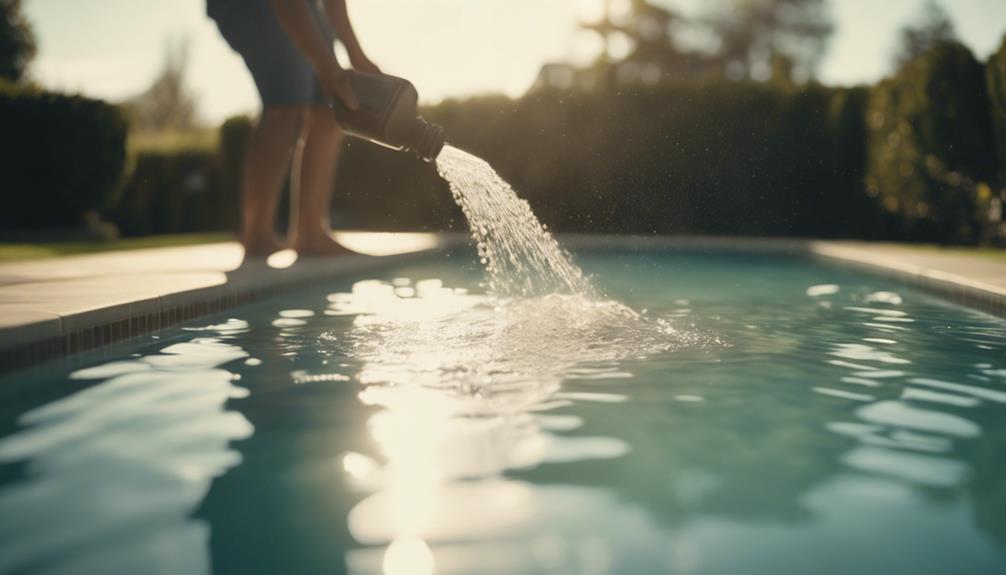
Using flocculant in your pool can significantly enhance water clarity and filtration efficiency. This aids in achieving a cleaner and visually pleasing swimming environment. Flocculant works by clumping particles together, allowing them to sink to the bottom for easier removal. To use it effectively, guarantee proper dosage, avoid disturbing settled particles, and run the pool pump for peak circulation. Address common issues like incomplete removal or balanced chemistry promptly. Following precise application tips and manufacturer instructions is crucial for maintaining a clear pool. Vacuuming thoroughly post-treatment is essential for crystal-clear water. Discover more benefits and details about using flocculant in your pool.
Key Takeaways
- Properly balance pH levels before applying flocculant.
- Allow flocculant to circulate for at least 2 hours.
- Vacuum pool thoroughly after particles settle.
- Follow manufacturer instructions precisely for best results.
- Dispose of excess flocculant properly to avoid environmental harm.
What Is Pool Flocculant?
Pool flocculant, whether inorganic or organic, plays an important role in maintaining the cleanliness and clarity of your pool water. When it comes to treating pool water, pool flocculant is essential for dealing with small particles that can make your pool water appear cloudy or murky.
Inorganic flocculants, such as aluminum sulfate, and organic flocculants, like polymers, are the two main types used for this purpose. Organic flocculants are generally more effective in water treatment compared to inorganic ones.
The function of pool flocculant is to create a floc blanket in the water, which binds with these small particles. This binding process causes the particles to clump together and eventually sink to the pool bottom. This process, known as coagulation, not only improves water clarity but also enhances filtration efficiency by making it easier to remove these particles during the filtration process.
Benefits of Using Flocculant
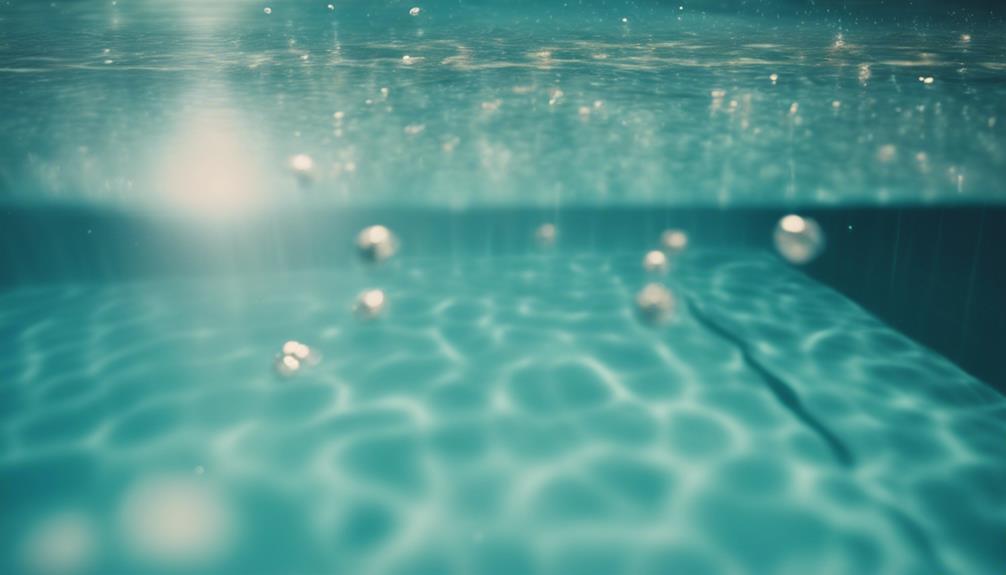
Using flocculant in your pool offers multiple benefits. It helps to quickly clear up cloudy water, enhancing water clarity and aesthetics.
Additionally, flocculant efficiently removes small particles, improving filtration efficiency and reducing the strain on your pool filter.
Clearer Water Quickly
Achieve clearer water quickly by leveraging the benefits of using flocculant in your pool. When dealing with cloudy pool water, flocculant is a game-changer.
Here's how it works:
- Invigorating Clumping: Flocculant causes tiny particles in the water to clump together, making them easier to eliminate.
- Efficient Filtration: By binding these clumped particles, flocculant helps them sink to the pool bottom, reducing the strain on your filter.
- Cost-Effective Solution: Not only does flocculant enhance water clarity, but it also offers a budget-friendly approach to maintaining your pool.
- Enhanced Aesthetics: Embrace the joy of swimming in a clear pool by utilizing flocculant for quick and effective results. Enjoy a sparkling pool that invites you to take a rejuvenating dip without delay.
Removes Small Particles
Enhance water clarity efficiently by utilizing flocculant to remove small particles like dirt, debris, algae, and bacteria from your pool. When you use flocculant, it works by binding these tiny particles together, forming larger clumps that are easier to filter out. This process, known as coagulation, enhances the filtration system's effectiveness, leading to a cleaner pool with improved clarity.
To illustrate the benefits of using flocculant in your pool for removing small particles, consider the following comparison table:
| Without Flocculant | With Flocculant |
|---|---|
| Small particles remain suspended in the water. | Small particles clump together for easier filtration. |
| Filtration system struggles to trap all particles. | Filtration system captures larger particle clumps effectively. |
| Water clarity may be compromised due to lingering particles. | Water clarity improves as particles are removed efficiently. |
| More frequent need for chemical treatments to combat algae and bacteria. | Reduced need for excess chemical usage and potential elimination of algaecides. |
Enhances Filtration Efficiency
By utilizing flocculant in your pool, you can boost filtration efficiency by aggregating small particles for easier removal. This process enhances water clarity by capturing and settling suspended debris, ultimately reducing strain on the pool filter system and extending its lifespan.
Additionally, the use of flocculant can noticeably reduce the amount of chemicals required to maintain water quality, promoting a more sustainable and cost-effective approach to pool maintenance.
Here are four key benefits of using flocculant in your pool:
- Improved Filtration Efficiency: Flocculant aids in aggregating small particles, making it easier for the filter to capture and remove them.
- Enhanced Water Clarity: By effectively removing suspended debris, flocculant contributes to clearer and cleaner pool water.
- Extended Lifespan of Pool Filter System: Reduced strain on the filter system leads to a longer-lasting and more efficient filtration system.
- Chemical Reduction: Using flocculant can decrease the reliance on additional chemicals, promoting a more balanced and eco-friendly pool maintenance routine.
When to Use Flocculant

Use flocculant in your pool when you notice extremely cloudy water or visible particles that won't filter out. Flocculant is particularly useful after heavy rain, during algae growth, or when debris causes the water to appear murky. If your regular pool filtration system is struggling to clear the water, it might be time to contemplate using flocculant. However, make sure that the water temperature is above 60°F for the flocculant to work effectively.
It's important to bear in mind that flocculant isn't a solution for routine pool maintenance but a targeted treatment for specific issues with your pool water. By promoting coagulation of particles, flocculant helps them settle to the bottom, making it easier to remove them through vacuuming or filtration.
How Does Flocculant Work?
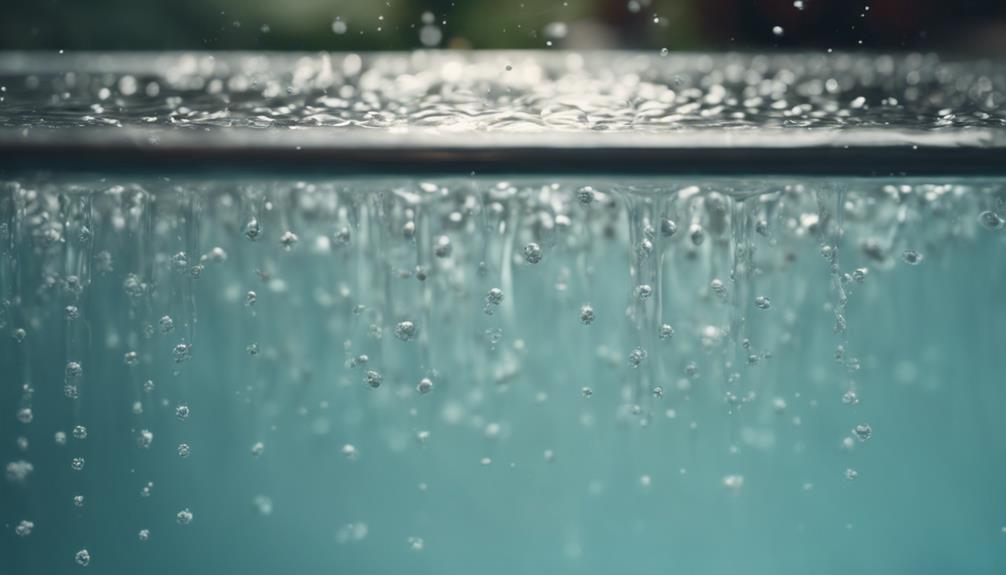
Flocculant works by causing small particles in your pool water to clump together, making them heavier and sink to the bottom of the pool. Here's how it achieves this:
- Clumping Together:
Flocculant initiates a process called coagulation, where it binds to smaller particles, facilitating the formation of larger and heavier clumps.
- Sink to the Bottom:
The heavier particles created by the clumping process gradually sink to the bottom of the pool, where they can be easily vacuumed or filtered out.
- Improve Water Clarity:
By removing suspended debris and contaminants, flocculant helps in enhancing the overall clarity of the pool water.
- Enhance Filtration Efficiency:
The removal of these particles not only improves water clarity but also boosts the efficiency of the pool's filtration system, reducing the need for excessive chemical treatments.
Understanding how flocculant works can help you effectively maintain your pool and ensure crystal clear water for an invigorating swim.
Proper Usage of Flocculant
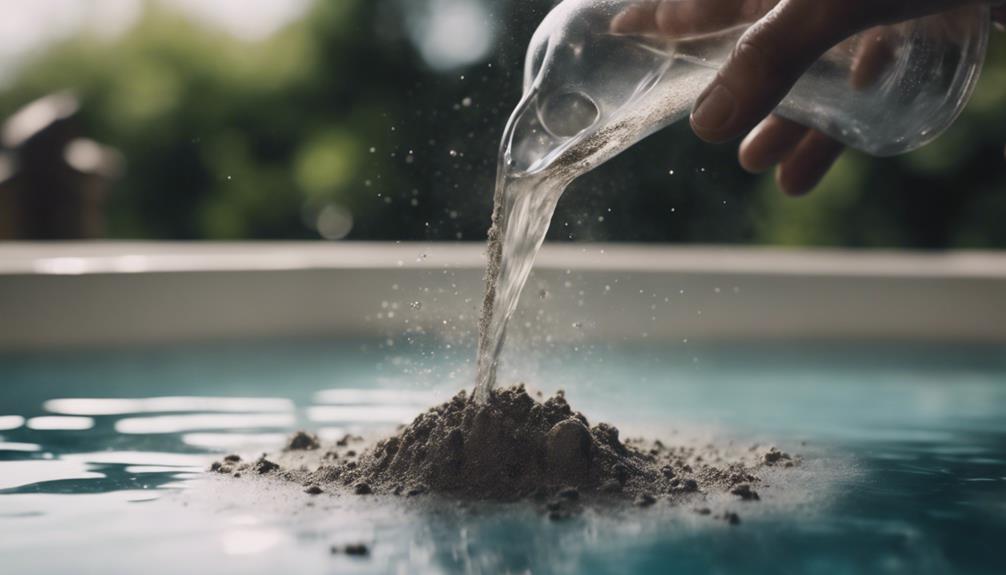
When using flocculant in your pool, it's important to add the correct amount according to your pool size and contamination levels.
Remember to pour the flocculant into the deepest part of the pool while the pump is running to guarantee even distribution.
Avoid the mistake of placing the flocculant directly into the skimmer basket or filter to prevent potential clogging issues.
Dos and Don'ts
Make sure to dilute the flocculant as per the manufacturer's instructions before adding it to your pool for best results.
When using flocculant in your pool, follow these dos and don'ts:
- Do test and balance the pool water pH levels before and after using flocculant for peak effectiveness.
- Avoid disturbing settled particles at the bottom of the pool while vacuuming to prevent clouding the water again.
- Run the pool pump for at least 2 hours after adding flocculant to ensure proper circulation.
- Avoid adding flocculant directly to the skimmer basket or filter; always add it to the deepest part of the pool with the pump running.
Application Tips
After understanding the dos and don'ts of using flocculant in your pool, guarantee proper application by diluting the product as instructed by the manufacturer for best results.
Essential dilution is vital to ensure the effectiveness of the flocculant. Add the flocculant slowly to the pool while the pump is running. This allows for even distribution of the product throughout the water.
Let the flocculant circulate in the pool for a minimum of 2 hours. This time allows the flocculant to clump together the particles in the water. Once the particles have settled to the bottom, vacuum the pool thoroughly. This step is crucial to achieve crystal clear water.
Remember to balance the pH levels of the pool both before and after using the flocculant. By following these application tips and manufacturer instructions precisely, you can enjoy a clean and clear pool for your relaxation and enjoyment.
Common Issues With Flocculant
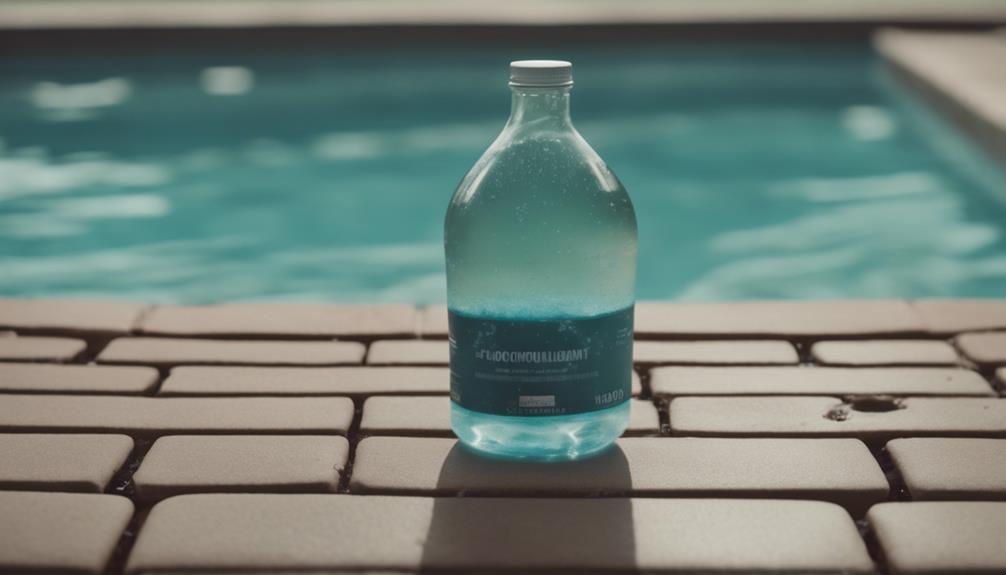
If you frequently notice cloudy water in your pool after using flocculant, you may be experiencing common issues with the treatment. Here are some common problems you might encounter:
- Incomplete Removal: Flocculant may not effectively remove all algae and debris, leading to persistent cloudiness.
- Unbalanced Chemistry: Incorrect chemical levels can interfere with the flocculant's performance, causing cloudy water.
- Improper Application: Using too much or too little flocculant can result in re-clouding or ineffective clumping of particles.
- Robotic Cleaners and Inadequate Vacuuming: Robotic cleaners may disturb settled particles, while insufficient vacuuming can leave lingering debris, both contributing to cloudy water.
If you face these issues, consider troubleshooting steps like retesting water chemistry, adjusting pH levels, and ensuring proper filtration and vacuuming techniques are applied. By addressing these common problems, you can enjoy a clear and inviting pool.
Removing Excess Flocculant
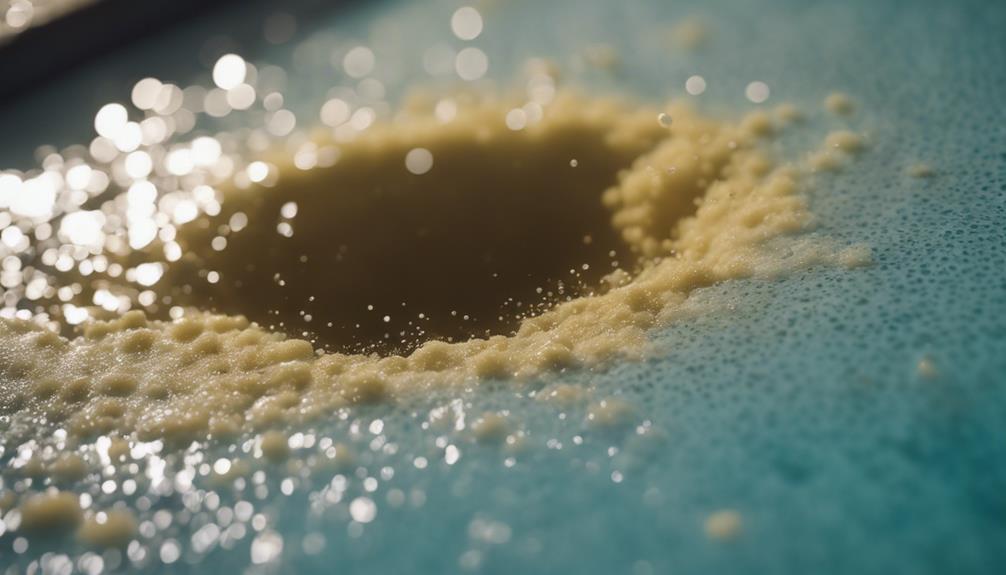
Experiencing an excess of flocculant in your pool can be remedied by effectively removing it using a pool vacuum on the Waste setting.
When vacuuming, focus on removing the particle clumps that have settled at the bottom of the pool. Slowly vacuum the pool to prevent stirring up settled debris, guaranteeing the efficient removal of excess flocculant.
After vacuuming, remember to top up the water level to maintain the proper balance. The particles, coagulated together by the flocculant in a process known as coagulation, can be efficiently eliminated by this method.
Dispose of the waste water following local regulations to avoid environmental harm. To monitor the water clarity post-flocculant removal, use a test kit to make sure the pool is balanced.
Keep an eye on the water clarity and balance, as well as regularly check the DE filters and the filter multiport to maintain excellent pool conditions.
Comparison: Flocculant Vs. Clarifier
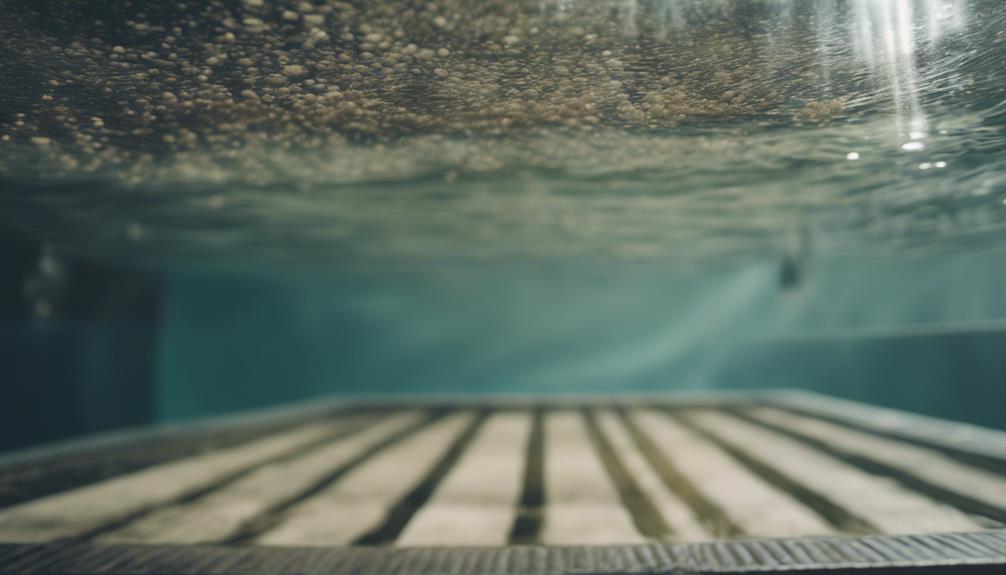
Comparing flocculant and clarifier reveals distinct differences in their mechanisms for improving water clarity in pools.
- Flocculant: This product works by clumping particles together, making them heavier to sink to the pool bottom. It requires vacuuming the settled particles for removal.
- Clarifier: Unlike flocculant, clarifier catches particles in the pool filter by coagulating them into larger masses that can be easily trapped.
- Filter Maintenance: When using flocculant, the pool filter is typically set to 'Recirculate' to avoid clogging, while clarifier aids in preparing particles for filter capture.
- Speed of Action: Flocculant acts faster than clarifier, usually within hours, providing quick and efficient results through the manual removal of clumped particles.
Understanding these distinctions can help you choose the right product based on your pool's needs, whether you prefer quick results with flocculant or a filter-dependent approach with clarifier.
Frequently Asked Questions
Can You Add Flocculant Directly to a Pool?
Yes, you can add flocculant directly to a pool, but it's important to do so correctly. Avoid pouring it into the skimmer basket or filter to prevent damage and clogging.
Instead, add flocculant to the deepest part of the pool with the pump running for even distribution. Following manufacturer instructions on how to add flocculant is essential for best results and to prevent filter issues.
Proper distribution helps the flocculant clump particles effectively for removal.
When Should I Use Flocculant in the Pool?
When dealing with extremely cloudy water caused by small particles in your pool, consider using flocculant. It's effective after heavy rain, algae blooms, or high debris levels from pool parties.
Flocculant isn't for regular maintenance but specifically targets water clarity issues when filtration alone isn't enough. It helps clear water effectively by clumping together tiny particles that are too small for the filter to catch.
Use it for quick results before special events or when needed.
Can You Run Flocculant Through Filter?
You shouldn't run flocculant through the filter in your pool. Doing so can lead to clogging and decrease the filter's efficiency.
For best results, add flocculant directly to the pool water and let it circulate before settling.
Always add flocculant to the deepest part of the pool with the pump set to 'Recirculate.'
The main purpose of flocculant is to clump small particles for easier removal, not to pass through the filter, avoiding potential damage.
How Much Floc Do I Need for a 10000 Gallon Pool?
For a 10000 gallon pool, you typically need around 8 ounces (1/2 pound) of flocculant. The amount required may vary based on the product's brand and concentration. It's important to adhere to the manufacturer's guidelines for accurate dosing.
Adjust the flocculant amount based on the water's cloudiness or particle level. After adding the flocculant, running the filter for 24 hours aids in efficient particle removal.
Conclusion
To guarantee, using flocculant in your pool can help clarify water by clumping together fine particles for easier removal.
One interesting statistic to take into account is that a properly maintained pool can save up to 50% on water and chemical costs compared to a neglected pool.
By understanding how flocculant works and when to use it, you can ensure your pool stays clean and clear all season long.
Pool Maintenance
Clear Water: How to Use Flocculant in Your Swimming Pool
Leverage the power of flocculant for your pool to achieve sparkling clarity – find out how in this comprehensive guide.

To use flocculant effectively for your swimming pool, start by determining the correct dosage based on your pool size and volume. Maintain a pH level between 7.4 and 7.6 for best results. Add the flocculant while the filter is set to 'Recirculate' and follow manufacturer instructions carefully. Allow the flocculant to settle overnight, then vacuum the settled particles using the 'Waste' setting on the filter. Make sure proper circulation for at least 2 hours post-flocculation. By mastering these steps, you'll achieve crystal clear water in your pool.
Key Takeaways
- Determine correct flocculant dosage based on pool size and water volume.
- Maintain pH between 7.4-7.6 and add flocculant on 'Recirculate' filter setting.
- Allow flocculant to settle for 8-24 hours before vacuuming on 'Waste' setting.
- Regular use of flocculant per manufacturer's instructions ensures crystal clear water.
- Vacuum slowly post-settling to remove particles and maintain pool water balance.
Benefits of Using Flocculant
Why should you consider using flocculant in your swimming pool?
Flocculant is a powerful tool in maintaining crystal clear pool water. By adding flocculant to your pool, you allow it to work its magic by causing small particles in the water to clump together. These clumps of particles become heavy enough to sink to the bottom of the pool, resulting in improved water clarity.
Not only does this process clear out cloudy pool water quickly, but it also reduces the need for frequent filter cleaning. This means less time spent on pool maintenance and more time enjoying your pool.
Additionally, using flocculant is a cost-effective solution that can save you money in the long run. So, if you want to enhance the clarity of your pool water, simplify your pool maintenance routine, and save on filter cleaning, incorporating flocculant into your pool care regimen is a smart choice.
Determining the Correct Dosage
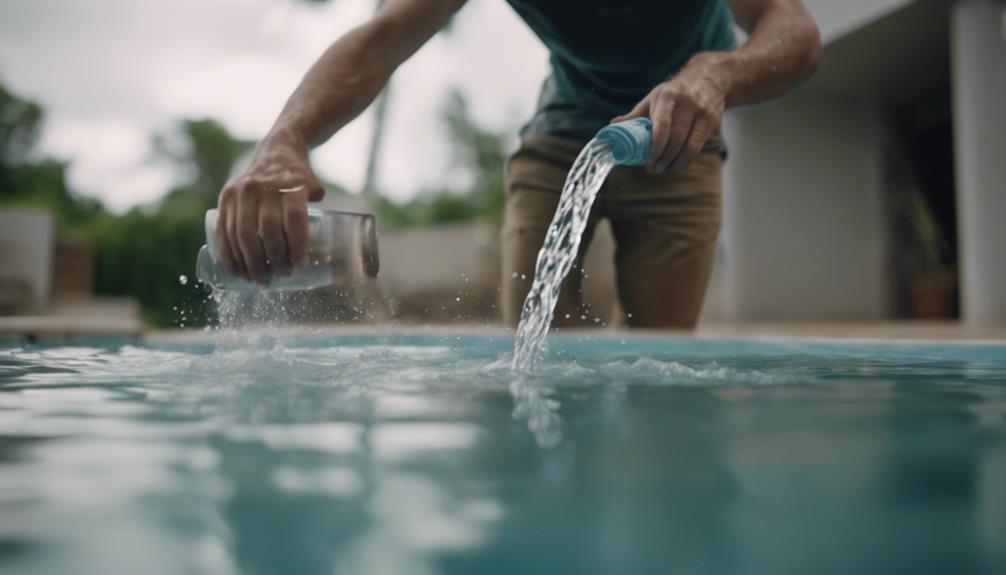
To guarantee proper use of flocculant in your swimming pool, ascertain the correct dosage based on factors such as pool size and water volume.
The best results for clear water depend on using the right amount of pool flocculant. Manufacturer instructions offer specific guidelines on the appropriate dosage tailored to your pool's needs.
Overuse of the flocculant can lead to water quality issues, while underuse may result in ineffective cleaning. It's essential to conduct research and understand the proper dosage for your specific pool to ensure clear and clean water.
Adding Flocculant to Pool Water
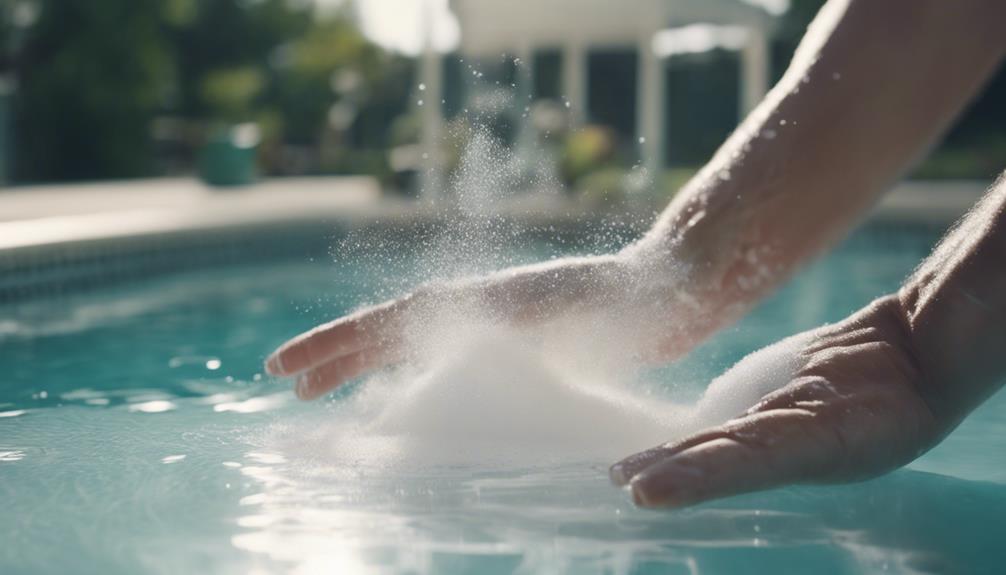
When adding flocculant to your pool water, it's essential to maintain a balanced pH level between 7.4 and 7.6 to guarantee peak effectiveness.
Remember to add the flocculant while the pool filter is set to 'Recirculate' to prevent clogging issues.
Additionally, the correct amount of flocculant should be added based on your pool's volume to achieve the desired results effectively.
Benefits of Flocculant
Using flocculant in your swimming pool enhances water clarity and cleanliness by effectively binding together tiny particles for easy removal. By adding flocculant to your pool water, you can experience a range of benefits:
- Improved Filtration: Flocculant works by clumping together small particles, allowing your pool filter to trap them more efficiently, resulting in cleaner water.
- Quicker Water Clarification: Cloudy or murky water can be quickly cleared up with the use of flocculant, saving you time and effort in maintaining your pool.
- Enhanced Removal of Impurities: Flocculant is effective in capturing algae, dirt, and other impurities that may not be caught by regular pool filters, ensuring a thorough cleaning process.
These benefits not only contribute to better water clarity but also enhance overall pool hygiene, providing you with a more enjoyable and invigorating swimming experience.
Flocculant is a convenient and efficient solution for achieving crystal clear pool water in a short amount of time.
Application Process Explained
Enhance the clarity and cleanliness of your swimming pool by following the simple application process for adding flocculant to your pool water. Start by adding the recommended amount of flocculant according to the manufacturer's instructions. Turn your pool filter to the 'Recirculate' setting to allow the flocculant to circulate for a minimum of 2 hours, effectively clumping particles together. Once the circulation period is complete, switch the filter setting to 'Waste' and manually vacuum the settled particles from the pool. If necessary, repeat the process until your pool water achieves crystal clear clarity.
| Application Process Steps | Details |
|---|---|
| 1. Add Flocculant | Follow manufacturer's instructions |
| 2. Circulate | Set filter to 'Recirculate' for 2 hours |
| 3. Vacuum | Switch filter to 'Waste' and manually vacuum |
| 4. Repeat if needed | For crystal clear water |
Maintenance Tips After Flocculation
To maintain the clarity and cleanliness of your pool water after adding flocculant, guarantee proper circulation for at least 2 hours.
Once the circulation period is complete, turn off the pump and let the flocculant settle at the bottom of the pool overnight.
The following day, utilize the Waste setting on your filter to carefully vacuum the settled particles from the pool floor.
Remember to top up the pool water level post-vacuuming to maintain proper water balance.
Additionally, make sure you balance the water chemistry after using flocculant to uphold crystal clear and healthy pool water.
Proper maintenance post-flocculation is essential for the effectiveness of the treatment and the overall well-being of your pool.
Allowing Flocculant to Settle

When allowing flocculant to settle in your pool, remember that the timing of this process is vital to achieve clear water. Waiting for about 8 to 24 hours allows the flocculant to bind particles effectively.
During this time, the treated particles will gradually sink to the pool's bottom, preparing them for efficient removal.
Settling Process Timing
For best results, allow the flocculant to settle in your swimming pool for a recommended period of at least 8-12 hours. The settling process is vital for the particles to clump together and sink to the bottom of the pool, resulting in clearer water.
Here are some key points to keep in mind during the settling process:
- Time Matters: Settling time may vary based on the amount of flocculant used and the current pool conditions. It's advisable to follow the manufacturer's guidelines for the best results.
- Overnight Settling: Allowing the flocculant to settle overnight is often recommended to ensure maximum effectiveness. Patience during this time is crucial to achieving crystal clear water.
- Avoid Disturbance: It's important not to disturb the settled particles while they're in the process of sinking to the bottom. Any disruption could impede the effectiveness of the flocculant, making it more challenging to achieve the desired outcome.
Clear Water Results
As the flocculant settles in your pool water, small particles begin to clump together for easier removal. It's essential to let the flocculant work overnight or for a minimum of 8 hours to achieve best results.
During this time, the settled particles will form a visible layer at the bottom of your pool, indicating the effectiveness of the flocculant. Patience is key in this process; the longer you allow the flocculant to work, the clearer your pool water will become.
Once the flocculant has settled the particles, you can proceed with manual vacuuming to effectively remove the debris from your pool. This combination of settling the particles with flocculant and manual vacuuming is vital for maintaining clear water in your pool.
Vacuuming the Pool
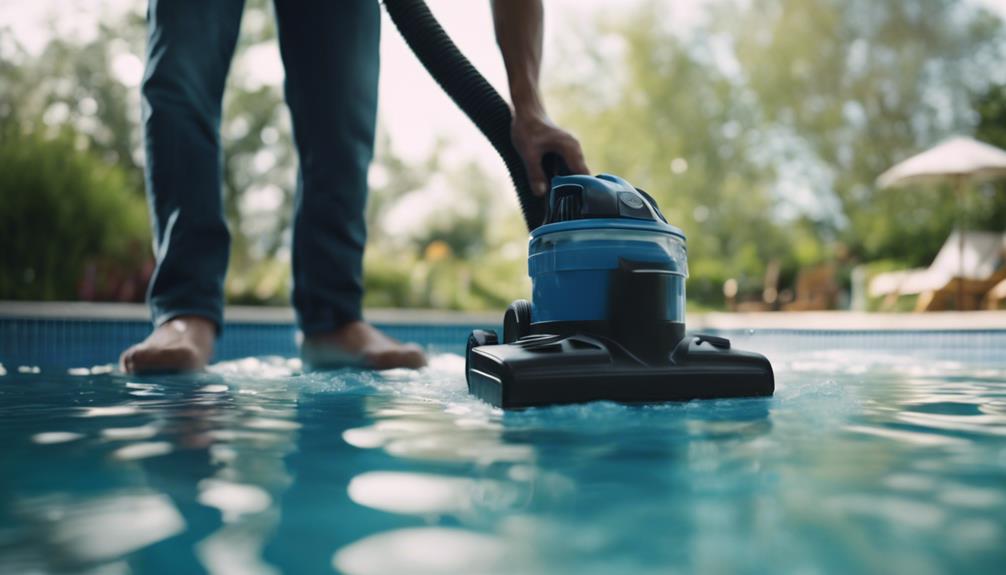
To effectively remove settled particles in your swimming pool after adding flocculant, vacuum the pool using slow and steady motions. This step is essential for pool maintenance to guarantee a clear and clean pool.
Here are some key tips to keep in mind:
- Use the 'Waste' Setting: When vacuuming after adding flocculant, make sure to use the 'Waste' setting on your filter. This setting allows you to vacuum out the waste water along with the particles, keeping your pool clean.
- Slow and Steady Vacuuming: Avoid stirring up settled debris by vacuuming slowly and steadily. This method helps to effectively remove settled particles without causing them to disperse back into the water.
- Top Up Pool Water: After vacuuming the pool, remember to top up the water to maintain proper levels. This simple step helps to ensure that your pool functions optimally and stays crystal clear.
Vacuuming the pool after using flocculant is a vital part of pool maintenance, contributing to a sparkling swimming experience.
Regular Use for Pristine Water

Consistently using flocculant in your swimming pool is key to maintaining pristine water quality. Adding this chemical once or twice a week plays a vital role in keeping your pool water clear and clean.
To guarantee best results, always follow the manufacturer's instructions for flocculant dosage.
By using flocculant regularly, you help in capturing small particles that may cloud the water, thereby maintaining crystal clear water in your pool.
Incorporating flocculant into your routine pool maintenance can effectively prevent issues like cloudy water and algae buildup.
Remember, the key to enjoying a sparkling pool lies in the regular use of flocculant as part of your maintenance regimen.
Stay proactive in caring for your pool, and you'll consistently enjoy the benefits of pristine, inviting water for all your swimming and leisure activities.
Frequently Asked Questions
How to Use Flocculant in a Swimming Pool?
To use flocculant in a swimming pool, follow these steps:
- Add the recommended amount based on your pool's volume.
- Let the pool pump run for at least 2 hours to distribute the flocculant evenly.
After 8 hours, vacuum the pool to remove settled particles at the bottom.
For better results, consider adding flocculant in the evening for overnight settling.
Don't forget to top up the pool water after vacuuming to maintain the proper water level.
How Much Liquid Flocculant Do I Put in My Pool?
You should consider the size of your pool and the manufacturer's guidelines when determining the amount of liquid flocculant to add.
A general rule of thumb is using around 8 ounces to 1 quart of liquid flocculant per 10,000 gallons of water.
Following the recommended dosage is essential to prevent issues like water clarity problems.
Over-treating or under-treating can lead to ineffective results, so make sure you measure accurately for best pool water clearing.
Can You Add Flocculant and Chlorine at the Same Time?
You shouldn't add flocculant and chlorine at the same time. It's generally recommended to add them separately due to potential chemical reactions.
Chlorine is essential for sanitizing the pool, while flocculant is used to clarify cloudy water. Adding them individually allows each chemical to effectively perform its specific function.
Start by adding chlorine first to sanitize the water, then follow with flocculant to clear particles, ensuring best results for your pool maintenance.
Will Floc Clear a Green Pool?
Yes, floc can effectively clear a green pool by clumping together algae particles for easier removal. It accelerates the process compared to traditional methods, making it an ideal solution for severe algae blooms causing green water.
Proper dosage and application of floc are essential for successful results. Remember to vacuum the settled particles post-treatment to achieve a clear and inviting swimming pool.
Conclusion
To sum up, using flocculant in your swimming pool can effectively clarify cloudy water by removing small particles and debris. By following the correct dosage, allowing the flocculant to settle, and then vacuuming the pool, you can maintain clear and pristine water for a more enjoyable swimming experience.
Regular use of flocculant will help keep your pool water crystal clear, ensuring a clean and inviting environment for you and your guests.
Pool Maintenance
Saltwater Pool Maintenance: How to Care for a Saltwater Swimming Pool
Optimize your saltwater pool maintenance routine with expert tips to ensure crystal-clear water and a refreshing swim every time.
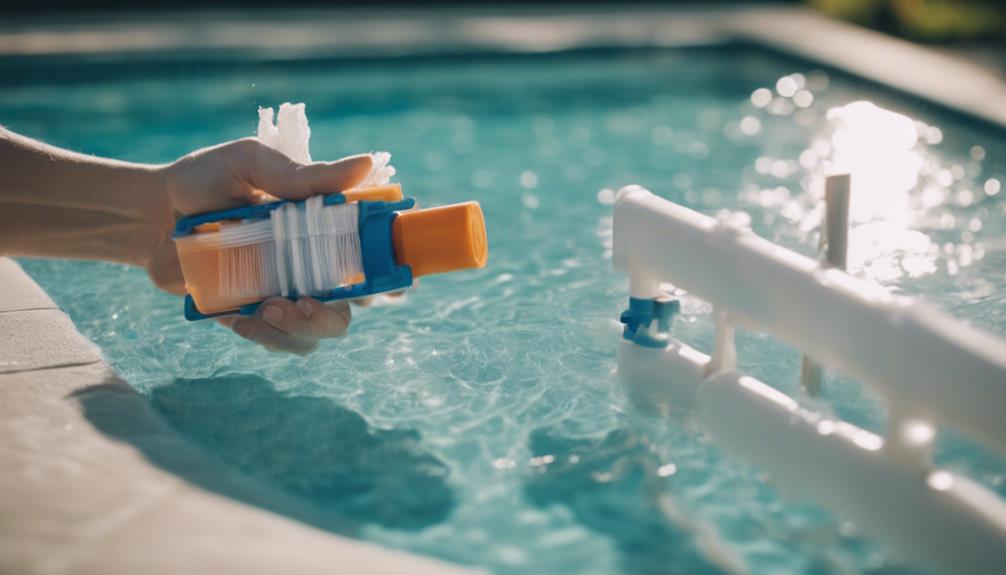
To care for a saltwater swimming pool, make sure you use 99% pure pool-grade salt and maintain salinity levels at 2,700-3,400 PPM. Run the pool pump for at least 8 hours daily for proper circulation, preventing debris buildup, algae growth, and ensuring even salt and chlorine distribution. Balance pH levels to prevent calcium buildup and regularly clean the salt cell to maintain chlorine production. Monitor pH (7.2-7.6) and free chlorine (1-3 ppm) levels for a safe swimming environment, shock the pool weekly, and perform regular cleaning and water quality testing to prevent issues. Following these steps guarantees the best pool maintenance.
Key Takeaways
- Use pool-grade salt with at least 99% purity to maintain salinity levels.
- Ensure proper water circulation by running the pump and filter for 8 hours daily.
- Prevent calcium buildup by maintaining pH levels and testing calcium hardness.
- Regularly clean the salt cell every 3 months to avoid water quality issues.
- Maintain balanced pH and chlorine levels through weekly testing and adjustments.
Proper Salt Addition
To properly maintain your saltwater pool, make sure you use pool-grade salt that's at least 99% pure when adding salt to the water. Maintaining the correct salt levels is essential for the best performance of your pool, with the recommended salinity level falling between 2,700 to 3,400 parts per million (PPM).
When adding salt, guarantee proper distribution by turning on the pool filter system to circulate the salt for 24 hours. This step is important to achieve thorough mixing and prevent localized high concentrations of salt.
To accurately monitor the salt levels, use a digital salinity tester to check various areas of the pool, ensuring uniformity. Regularly testing and adjusting salt levels around the pool is crucial to maintain water quality and prevent any potential issues that may arise from inconsistent salinity levels.
Maintaining Water Circulation
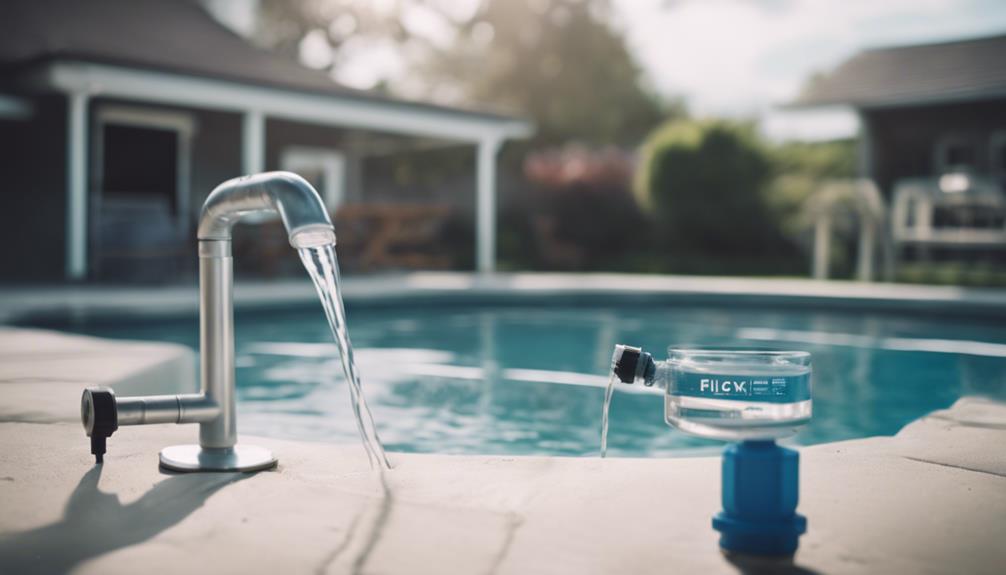
For peak water quality and pool cleanliness, make sure you run the pool pump and filter for a minimum of 8 hours daily to maintain proper circulation in your saltwater pool.
Adequate water circulation is vital for evenly distributing salt and chlorine throughout the pool, which is essential for effective sanitation. By ensuring proper water circulation, you can prevent the buildup of dirt and debris, thereby contributing to the overall cleanliness of your pool.
Additionally, consistent circulation helps maintain balanced water chemistry by evenly dispersing chemicals, creating a safe swimming environment for you and your family.
Stagnant areas in the pool are minimized through continuous water circulation, reducing the risk of algae growth and other water quality issues.
Preventing Calcium Buildup
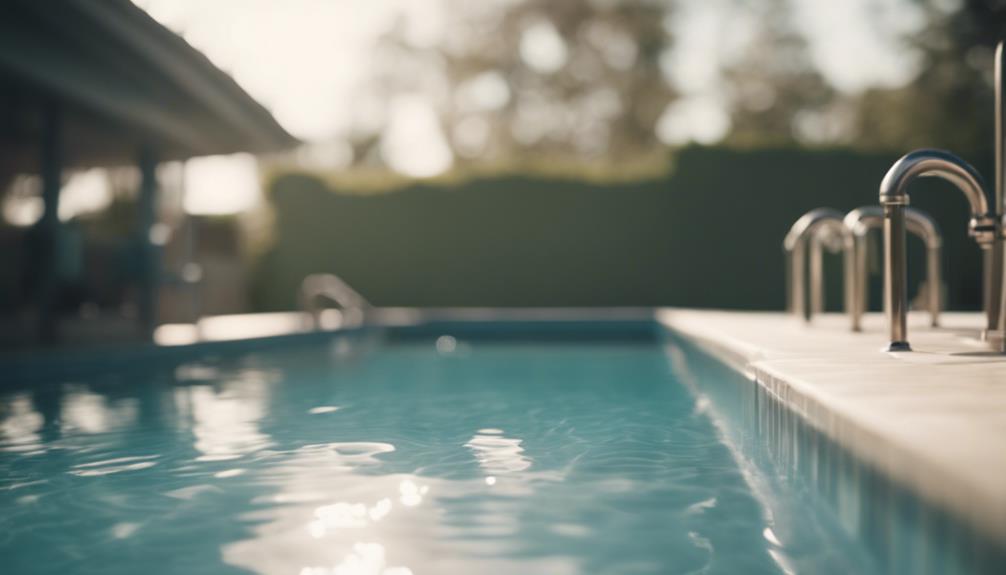
Maintain proper pH levels to prevent calcium buildup around your pool and avoid scaling and corrosion.
Calcium buildup occurs when the water becomes oversaturated with calcium, leading to the formation of scaling on pool surfaces. To prevent this, it's important to monitor and regulate the pH levels in your pool regularly.
Imbalanced pH levels can contribute to the precipitation of calcium, resulting in unsightly deposits that are challenging to remove. Additionally, maintaining proper water chemistry is vital in preventing calcium buildup.
By routinely testing and adjusting the calcium hardness levels in your pool, you can avoid excessive accumulation of calcium that can lead to scaling issues. Using a calcium remover or a mild acid solution can help dissolve existing calcium deposits and prevent new buildup.
Checking Salt Cell Cleanliness
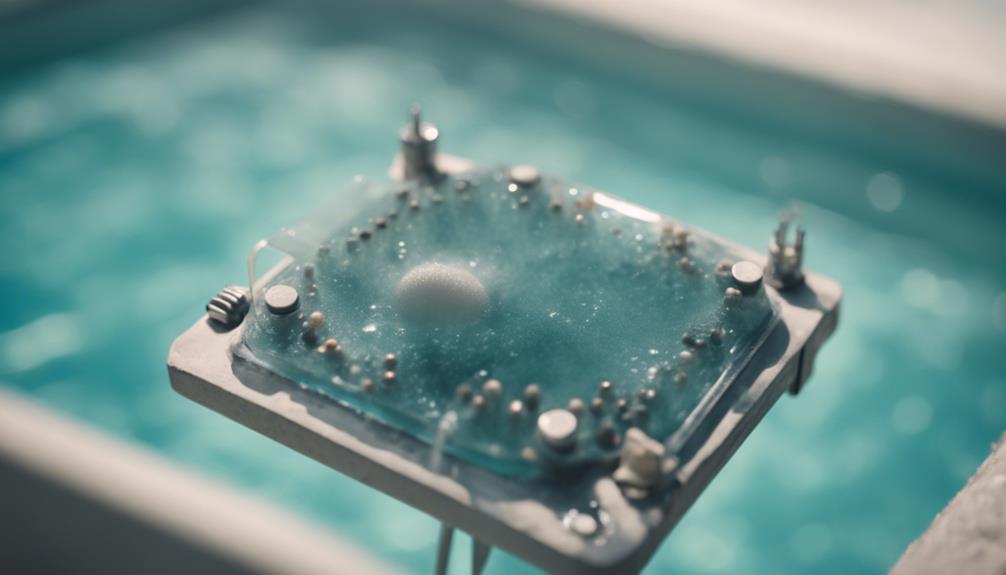
When it comes to maintaining your saltwater pool, checking the cleanliness of your salt cell is essential. Regularly inspecting the salt cell every 3 months can help prevent scale buildup and guarantee efficient chlorine generation.
Use a high-pressure hose or consider a mild acid wash to clean out any deposits that may hinder its performance.
Salt Cell Inspection
Regularly inspecting the salt cell every 3 months for calcium buildup or scale deposits is essential for maintaining the efficiency of your salt chlorinator system. When you inspect the salt cell, keep an eye out for any signs of white deposits or flakey spots on the surface. These can indicate the presence of calcium buildup or scale deposits, which can hinder the proper functioning of your salt chlorinator. By catching these issues early through regular inspections, you can guarantee that your salt cell continues to operate effectively.
Inspecting the salt cell is a simple yet important step in your pool maintenance routine. If you notice any buildup or deposits, you can then proceed to clean the salt cell using a high-pressure hose or a mild acid solution. Following the manufacturer's instructions for cleaning is crucial to prevent damage to the salt cell.
Cleaning Process
Check the cleanliness of your salt cell regularly to guarantee maximum chlorine production and prevent maintenance issues. Scale buildup on the salt cell can impede chlorine production, leading to water quality problems.
Inspect the salt cell every three months for any deposits or scaling. If you notice buildup, use a high-pressure hose or a mild acid solution to clean the cell thoroughly.
Proper maintenance of the salt cell is essential for efficient chlorine production and to extend the life of the cell. Neglecting to clean the salt cell can result in decreased chlorine levels, potentially causing algae growth or other water quality issues.
Following the manufacturer's guidelines for cleaning the salt cell is vital to ensure safe and effective maintenance. Remember to wear appropriate protective gear, such as gloves and goggles, when handling chemicals during the cleaning process.
Balancing Ph and Chlorine Levels
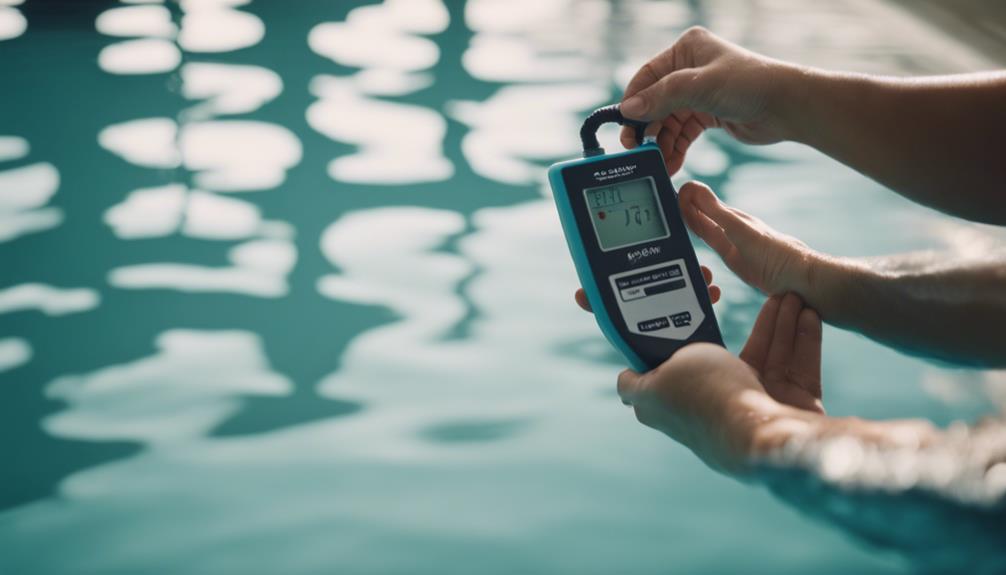
Maintaining the appropriate pH levels between 7.2-7.6 is essential to prevent skin and eye irritation in your saltwater pool.
Monitoring free chlorine levels at 1-3 ppm is vital for effective sanitation and algae prevention.
Properly balancing your pool's chemistry by adjusting chlorine and pH levels through regular testing ensures a safe and comfortable swimming environment for you and your guests.
Ph Level Importance
Properly balancing the pH and chlorine levels in your saltwater pool is essential for maintaining water clarity and sanitation. pH balance, ranging from 7.2 to 7.6, is vital for the effectiveness of free chlorine levels in your pool.
When pH levels are imbalanced, it can lead to poor chlorine performance, potentially causing algae growth and jeopardizing water quality. Regularly testing and adjusting pH levels is key to ensuring that your pool remains clean and safe for swimming.
High pH levels can reduce chlorine's effectiveness, requiring more chemicals and increasing maintenance costs. By monitoring and maintaining the correct pH levels in your saltwater pool, you not only promote efficient chlorine function but also guarantee a safe and enjoyable swimming experience for everyone.
Chlorine Level Monitoring
To maintain ideal sanitation and water quality in your saltwater pool, consistent monitoring of chlorine levels is essential for guaranteeing a safe and enjoyable swimming environment. Keeping the chlorine levels within the recommended range of 1-3 parts per million (ppm) is critical to effectively sanitize the pool water.
Additionally, balancing pH levels between 7.2-7.6 is essential to prevent skin and eye irritation and to ensure the effectiveness of chlorine in keeping your pool clean. Remember to adjust the chlorine output as needed based on regular test results to maintain a healthy swimming environment.
Properly balanced pH and chlorine levels are the key to a pleasant and safe swimming experience in your saltwater pool.
- Regularly test and monitor chlorine levels.
- Maintain chlorine levels between 1-3 ppm.
- Balance pH levels between 7.2-7.6.
- Adjust chlorine output based on test results.
- Ensure proper pH and chlorine levels for a healthy swimming experience.
Balancing Pool Chemistry
Regularly testing and adjusting pH and chlorine levels in your saltwater pool is essential for maintaining water balance and sanitation. pH levels should be tested weekly, aiming for a range of 7.2-7.6 to maintain proper water balance.
Monitoring and adjusting free chlorine levels between 1-3 ppm is important for effective sanitation. Utilize baking soda to raise pH levels and sodium carbonate or muriatic acid to lower them as needed.
Maintaining appropriate chlorine levels not only prevents algae growth but also ensures the safety of the water. Balancing pH and chlorine levels is crucial to prevent equipment corrosion and maintain high water quality standards.
Weekly Pool Shocking

To maintain your saltwater pool effectively, make sure to shock it weekly with a high dose of chlorine to eliminate bacteria, algae, and contaminants. This weekly shocking routine is essential for maintaining water clarity and sanitation in your saltwater pool.
Factors such as heavy pool use, high temperatures, and rainfall can increase the need for weekly shocking to keep the water clean and safe for swimming. When selecting a shock treatment, opt for a non-chlorine shock specifically designed for saltwater pools to prevent damage to the system.
Regular pool shocking not only kills bacteria and algae but also helps prevent common issues like cloudy water, algae growth, and unpleasant odors. By incorporating weekly shocking into your pool maintenance routine, you can ensure that your saltwater pool remains an invigorating and enjoyable oasis for you and your family to relax and swim in.
Skimming, Brushing, Vacuuming
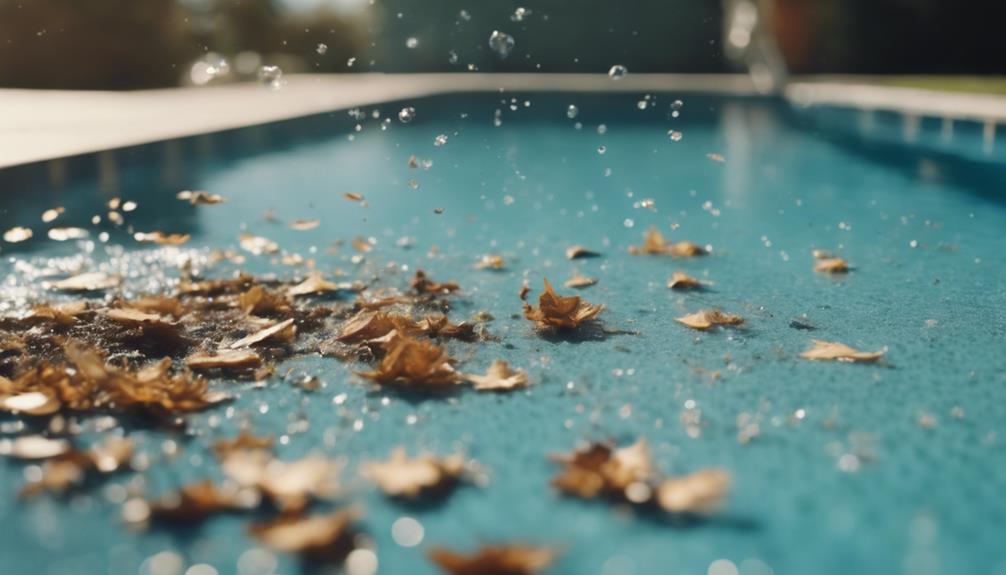
Maintaining a clean and clear saltwater pool involves daily skimming to remove debris and prevent buildup in the water. By skimming the pool surface regularly, you can prevent leaves, bugs, and other debris from sinking to the bottom and causing water quality issues.
Additionally, brushing the pool walls and floor on a weekly basis is important to prevent algae growth and maintain overall cleanliness. Algae can quickly spread in neglected areas, leading to cloudy and uninviting water.
Moreover, vacuuming the pool at least once a week is essential to remove dirt, leaves, and other debris that may have settled on the bottom. These routine maintenance tasks, including skimming, brushing, and vacuuming, play a significant role in keeping your saltwater pool crystal clear and reducing the need for excessive chemical treatments.
Regular Water Quality Testing
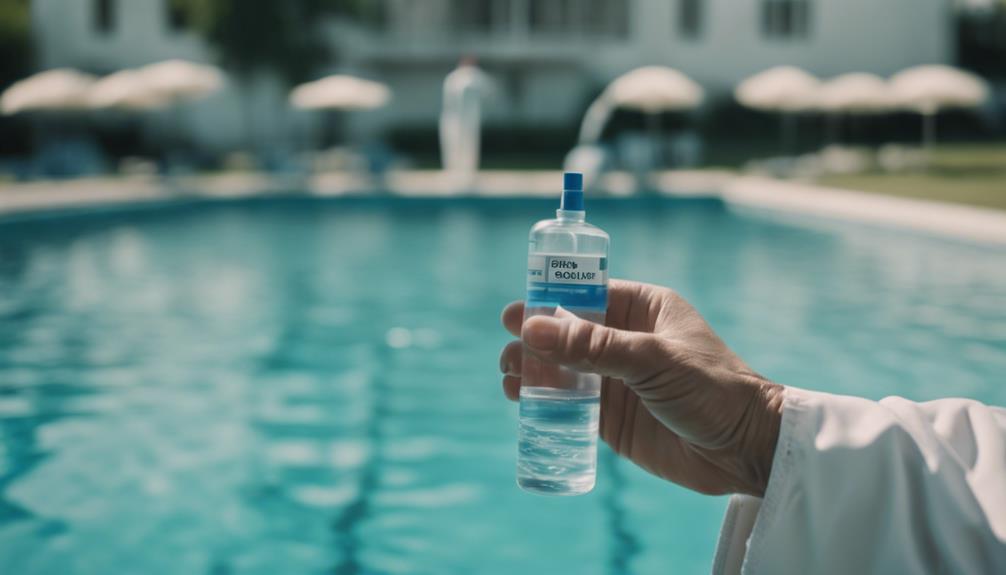
Guarantee proper sanitation and safety for swimmers by testing the free chlorine levels weekly in your saltwater pool.
Monitoring pH levels is also vital, especially considering the naturally high pH in saltwater systems. To maintain ideal water quality and prevent issues, it's vital to balance both pH and chlorine levels.
Additionally, testing alkalinity, stabilizer, and calcium levels monthly is key to ensuring a well-balanced pool environment. Aim to keep alkalinity levels between 100 and 150 parts per million (PPM) for the best pool water chemistry.
- Test chlorine levels weekly: Ensures safe swimming conditions.
- Monitor pH levels regularly: Prevents imbalances that can lead to skin and eye irritation.
- Balance pH and chlorine levels: Maintains water quality and prevents algae growth.
- Test alkalinity, stabilizer, and calcium levels monthly: Ensures a well-balanced pool chemistry.
- Maintain alkalinity between 100 and 150 PPM: Best for pool water chemistry.
Troubleshooting Common Issues
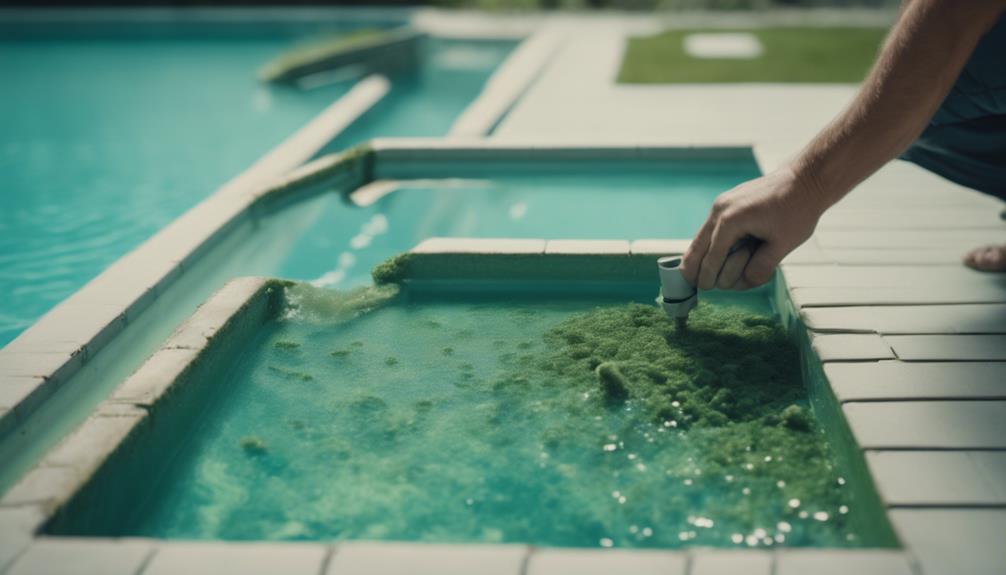
Troubleshoot common issues in your saltwater pool by identifying and addressing factors contributing to cloudy water, algae growth, and corrosion. Cloudy water often indicates a chlorine deficiency or a poorly functioning filtration system. To combat algae growth, ensure proper chlorine levels are maintained and run the pool pump regularly. Corrosion problems can arise from high salt levels, requiring diligent monitoring and dilution of concentrations. Regularly testing pH, alkalinity, and salt levels is crucial in troubleshooting and preventing common saltwater pool issues. By staying on top of maintenance tasks and testing water quality consistently, you can detect and address water quality problems early, ensuring a safe swimming environment for you and your family.
—
| Common Issue | Causes | Solutions |
|---|---|---|
| Cloudy Water | Chlorine deficiency, poor filtration | Test and adjust chlorine levels, check filtration system |
| Algae Growth | Insufficient chlorine, lack of regular pump operation | Maintain proper chlorine levels, run pump regularly |
| Corrosion Issues | High salt levels | Monitor, dilute salt concentrations as needed |
Converting to Saltwater Pool
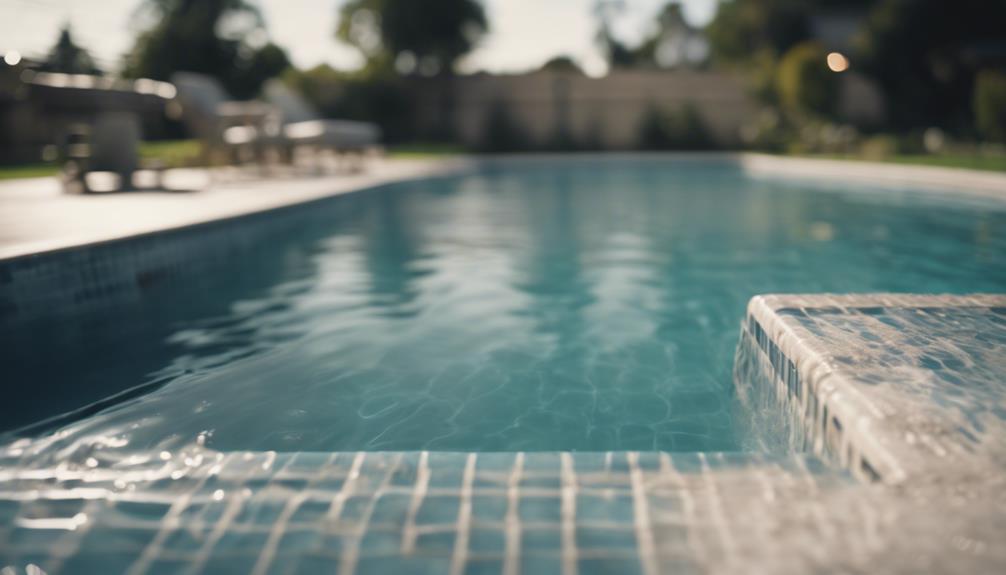
To successfully convert your traditional pool into a saltwater pool, start by purchasing a saltwater chlorinator system designed for your specific pool size and requirements.
Ensure a smooth changeover by following these steps:
- Drain and Clean: Prepare your pool by draining and cleaning it thoroughly before installing the saltwater system to guarantee peak performance.
- Add Salt: Follow manufacturer instructions and add the correct amount of pool-grade salt based on your pool's size to achieve the desired salinity.
- Test pH Levels: Regularly test and adjust pH levels after the conversion to maintain proper water balance and comfort for swimmers.
- Secure Connections: Before activating the saltwater system, verify that all connections are secure to prevent potential leaks or malfunctions that could impact the conversion process.
- Maintenance: Stay proactive with regular upkeep and monitoring to keep your saltwater pool in top-notch condition for long-term enjoyment.
Frequently Asked Questions
What Is Routine Maintenance for a Salt Water Pool?
Routine maintenance for a saltwater pool involves weekly tasks such as pH level testing and adjustment, and regular monitoring and adjustment of free chlorine levels for sanitation.
Maintaining the correct salinity level of 2,700 to 3,400 PPM is essential for pool health. Cleaning and inspecting the salt cell every 3 months ensures ideal chlorine generation.
Additionally, weekly tasks like skimming, brushing, and vacuuming help keep the water clear and free of debris.
Is It Difficult to Maintain a Saltwater Pool?
Maintaining a saltwater pool is generally easier than a traditional chlorinated pool due to the self-regulating nature of salt chlorination systems. The process requires less monitoring and adjustment of chlorine levels, reducing maintenance efforts.
While initial setup costs may be higher, long-term maintenance expenses are often lower. Regular testing of salt levels and water chemistry, along with cleaning the salt chlorinator cell, are key tasks for proper upkeep.
Soft, gentle water and reduced skin and eye irritation are benefits of well-maintained saltwater pools.
Do You Need to Add Chemicals to a Saltwater Pool?
Yes, you need to add chemicals to a saltwater pool.
Despite the misconception that saltwater pools are maintenance-free, you still require regular monitoring and adjustment of pH, alkalinity, stabilizer levels, and occasional additions of muriatic acid, shock treatment, or algaecides.
Testing for free chlorine and salt levels is vital for water quality.
While saltwater pools generate chlorine, supplemental chemicals are essential for balance and safe swimming conditions.
How Often Should I Add Salt to a Salt Water Pool?
You should add salt to your saltwater pool when levels fall below the recommended range of 2,700 to 3,400 parts per million (PPM).
Factors like heavy rain, splash out, or dilution from adding fresh water can lower salt levels. Use a digital salinity tester to measure salt levels accurately in various pool areas.
Adding salt after rain or water addition helps maintain ideal salinity for efficient chlorine generation. Remember to turn off the chlorine generator while adding salt for proper distribution and functionality.
Conclusion
In summary, maintaining a saltwater pool doesn't have to be a challenging task. By following the proper care and maintenance steps outlined in this article, you can guarantee your pool stays clean, safe, and enjoyable for all swimmers.
Remember, a little effort goes a long way in keeping your saltwater pool in top condition. So don't let misinformation deter you – with the right knowledge and approach, you can easily care for your saltwater swimming pool like a pro.
Pool Maintenance
Caring for a Saltwater Pool: Best Practices
Uncover the essential best practices for maintaining a saltwater pool to ensure crystal-clear water and optimal performance.

To care for your saltwater pool effectively, maintain a salinity level of 2,700-3,400 parts per million for clear water and ideal equipment function. Regularly test chlorine levels and adjust as needed, ensuring proper pH balance and conducting shock treatments weekly. Keep pH levels between 7.2-7.6 to prevent algae growth and boost chlorine efficacy. Regularly clean the salt cell every three months to prevent buildup, and rinse the pool area to prevent erosion. It's essential to conduct monthly water tests and follow professional guidelines for a pristine swimming experience. Maintaining these practices will help you enjoy a safe and invigorating swim.
Key Takeaways
- Maintain salinity levels between 2,700-3,400 PPM for pool health.
- Test and adjust chlorine levels regularly for optimal performance.
- Keep pH levels between 7.2-7.6 to prevent algae growth.
- Clean salt cell every 3 months to maintain chlorine production.
- Conduct weekly shock treatments for water clarity and sanitation.
Proper Saltwater Pool Balance
To guarantee peak performance in your saltwater pool, maintain a salinity level between 2,700 to 3,400 PPM. This balance is essential for the overall health of your pool.
Salt is vital for generating chlorine through the process of electrolysis, ensuring clean and safe water for swimming. When the salinity levels are within the recommended range, the water remains clear, and the pool equipment functions at its best.
Additionally, proper salt levels help maintain the pH balance of the water. pH measures the acidity or alkalinity of the water, affecting both swimmer comfort and equipment longevity. By keeping the salt levels in check, you're also indirectly regulating the pH levels of your pool water.
Regular testing of the water using a digital salinity tester or salt water test strips is necessary to ensure these levels are within the desired range. Remember, a balanced saltwater pool leads to a more enjoyable swimming experience and prolongs the lifespan of your pool equipment.
Maintaining Chlorine Levels

To maintain proper chlorine levels in your saltwater pool, it's vital to test the water frequently and adjust as needed.
Balancing pH levels is also essential to guarantee the effectiveness of the chlorine in sanitizing the pool.
Don't forget the importance of shock treatments to keep the water free from contaminants and algae buildup.
Chlorine Testing Frequency
Regularly test your saltwater pool's chlorine levels to guarantee proper sanitation and safe swimming conditions. The chlorine testing frequency in a saltwater pool should be at least once a week to make sure that the free chlorine levels are between 1-3 ppm, maintaining a healthy environment for swimmers.
It's essential to adjust the salt chlorinator output based on the test results to keep the chlorine levels consistent and within the recommended range. Additionally, after periods of heavy pool use or severe weather conditions, closely monitoring the chlorine levels is important.
Balancing Ph Levels
Maintaining proper pH levels in your saltwater pool is essential for ensuring the effectiveness of chlorine and preventing issues like algae growth. To maintain chlorine effectiveness, it's important to keep pH levels within the ideal range of 7.2-7.6. Imbalanced pH levels can compromise chlorine's ability to sanitize the pool water, potentially leading to algae growth and other water quality problems. Regularly testing and adjusting the pH levels is necessary not only for chlorine effectiveness but also to prevent skin and eye irritation for swimmers.
High pH levels can reduce the potency of chlorine, requiring higher concentrations to maintain proper sanitation levels. This not only increases the cost of pool maintenance but can also be harsh on swimmers' skin and eyes.
Shock Treatment Importance
Ensuring proper chlorine levels in your saltwater pool is essential for maintaining water clarity and preventing algae growth. Shock treatment plays an important role in this process by helping to maintain adequate chlorine levels.
By eliminating contaminants and restoring sanitizer effectiveness, shock treatments help prevent algae growth and keep your pool water clear. It's recommended to shock your saltwater pool weekly or after heavy use to combat cloudy water caused by organic materials, ammonia, and other impurities that can reduce chlorine levels.
Regular shock treatments also aid in preventing chlorine-resistant bacteria, ensuring a safe and healthy swimming environment for you and your family. Following the manufacturer's guidelines for shock treatment is imperative to maximize performance and the longevity of your saltwater pool system.
Monitoring Ph Levels

To maintain peak efficiency and comfort in your saltwater pool, it is important to monitor the pH levels within the range of 7.2-7.6. Keeping the pH balanced is essential for water quality and the effectiveness of chlorine in sanitizing the pool. High pH levels can reduce the chlorine's ability to keep the water clean, while low pH levels can cause equipment corrosion and skin irritation for swimmers. Regularly testing and adjusting the pH levels will ensure proper water balance and prevent potential issues. Monitoring pH levels is vital for the overall health and clarity of your saltwater pool.
| pH Level | Effect | Action |
|---|---|---|
| High | Reduced chlorine effectiveness | Add pH decreaser |
| Low | Equipment corrosion, skin irritation | Add pH increaser |
| Balanced | Ideal water quality | Maintain within 7.2-7.6 range |
Cleaning Salt Cell Regularly

Regularly cleaning the salt cell every 3 months is essential for preventing buildup and maintaining peak chlorine production in your saltwater pool. Neglecting this task can lead to accumulated debris and scale on the salt cell, hindering its efficiency and potentially causing maintenance issues down the line.
To guarantee the functionality of the salt cell, consider cleaning it with a diluted muriatic acid solution or using a high-pressure hose. Proper maintenance not only prolongs the salt cell's lifespan but also reduces the risk of corrosion or malfunction, ultimately contributing to the overall health and performance of your saltwater pool system.
Preventing Erosion and Buildup

To prevent erosion and buildup in your saltwater pool, always remember to rinse areas around the pool regularly to avoid damage from salt splash out. Salt splash out can gradually deteriorate surfaces, leading to costly repairs.
Additionally, keep an eye out for calcium carbonate buildup, often caused by high pH levels in the pool, which can result in scaling issues. Regularly cleaning the pool liner and automatic cover is vital to prevent buildup and extend their lifespan.
Maintaining balanced pH levels is essential not only for preventing calcium carbonate buildup but also to avoid equipment corrosion. Corrosion can greatly impact the pool's integrity and functionality. Make sure to test and balance pH levels consistently to safeguard your pool equipment.
Remember to inspect the salt cell every three months for calcium buildup. If necessary, clean it with a diluted muriatic acid solution to prevent performance issues.
Ensuring Water Circulation

Maintain proper water circulation in your saltwater pool to uphold balanced chemical distribution and prevent issues like algae growth and poor water quality. Essential circulation is vital for ensuring that sanitizers and chemicals are evenly dispersed throughout the pool, reducing the risk of algae growth, uneven chemical distribution, and degraded water quality.
Efficient water circulation also helps prevent stagnant areas, minimizes debris buildup, and promotes consistent water temperature throughout the pool. To achieve this, it's important to regularly run the pump and adjust circulation settings to optimize water flow and pool filtration.
Weekly Shock Treatments

Performing weekly shock treatments in your saltwater pool is essential for eliminating organic contaminants and maintaining water clarity.
These treatments help prevent algae growth, remove chloramines, and enhance the efficiency of chlorine in your pool.
Using a non-chlorine shock or a saltwater-specific shock product is recommended for best results.
Shock Treatment Importance
Consistently administering shock treatments in your saltwater pool is essential for preserving water quality and cleanliness. Weekly shock treatments play a crucial role in eliminating organic contaminants, bacteria, and algae from your pool water. By following a regular shock treatment schedule, you can prevent issues such as cloudy water, algae growth, and unpleasant odors, guaranteeing that your pool remains clear, safe, and inviting for swimmers.
To emphasize the importance of shock treatments, let's take a closer look at the benefits they offer:
| Benefits of Weekly Shock Treatments | Explanation |
|---|---|
| Eliminates Contaminants | Helps remove organic debris, bacteria, and algae. |
| Prevents Water Issues | Reduces the likelihood of cloudy water, algae growth, and unpleasant odors. |
| Maintains Water Quality | Ensures that your pool water remains clear, safe, and inviting for swimmers. |
| Enhances Overall Pool Experience | Contributes to a healthier and more enjoyable swimming environment. |
Proper Application Techniques
To guarantee effective weekly shock treatments in your saltwater pool, make sure to select a high-quality shock treatment product specifically formulated for saltwater pools to prevent damage to your pool system.
When applying shock treatments, follow the manufacturer's instructions meticulously to make certain the correct dosage and application techniques. Start by dissolving the shock treatment granules in a bucket of water before evenly dispersing the solution around the perimeter of the pool. This method helps prevent concentrated areas of shock treatment that could potentially damage pool surfaces.
Remember, shock treatments are essential for oxidizing organic contaminants, breaking down chloramines, and maintaining water clarity in your saltwater pool. By employing proper application techniques, you not only ensure the effectiveness of the shock treatment but also contribute to a clean and safe swimming environment by eliminating bacteria, preventing algae growth, and maintaining balanced water chemistry.
Regular maintenance through weekly shock treatments is key to enjoying a pristine saltwater pool all year round.
Frequency Recommendations
For ideal maintenance of your saltwater pool, it is recommended to conduct weekly shock treatments to uphold water clarity and sanitation. Shock treatments play an important role in oxidizing and eliminating organic contaminants that regular chlorine may not effectively address. Following the manufacturer's guidelines for the proper amount of shock treatment based on your pool size is essential to achieve best results. Factors such as heavy pool usage, weather conditions, and water quality can influence the frequency of shock treatments needed. By implementing regular shock treatments, you can effectively prevent algae growth and maintain a safe and inviting swimming environment for all.
| Frequency Recommendations | Benefits |
|---|---|
| Weekly shock treatments | Maintain water clarity and sanitation |
| Adjust based on usage, weather, and water quality | Prevent algae growth and ensure swimmer safety |
Regular Skimming and Brushing

Skim your saltwater pool surface daily to remove debris and prevent buildup that can affect water quality. Using a pool brush weekly is also essential to scrub the pool walls and floor, preventing algae growth and enhancing circulation. Regular skimming and brushing play an important role in maintaining a clean pool environment by reducing the strain on the filtration system.
Here are some essential practices for regular skimming and brushing:
- Daily Skimming: Removing debris such as leaves, insects, and other contaminants from the water surface prevents them from sinking and causing water quality issues.
- Weekly Brushing: Using a pool brush to scrub the walls and floor of the pool helps prevent algae growth, improves water circulation, and enhances the effectiveness of pool chemicals.
- Consistent Maintenance: Regular skimming and brushing not only keep your pool clean but also aid in evenly distributing chemicals, preventing scale buildup, and maintaining a sparkling and inviting pool for your enjoyment.
Monthly Water Testing

Maintain excellent water quality in your saltwater pool by conducting monthly water testing to monitor key chemical levels and prevent potential issues.
Testing the water chemistry of your saltwater pool on a monthly basis is essential to guarantee that the pH, alkalinity, and chlorine levels are within the recommended range. By regularly testing these levels, you can maintain a balanced pool environment and prevent water quality issues from arising.
Additionally, monitoring the salt levels monthly is important, as they should ideally fall between 3,000-5,000 parts per million (PPM) to ensure the proper functioning of your saltwater system.
Moreover, testing for calcium hardness and cyanuric acid monthly is equally important to prevent scaling, corrosion, and algae growth in your pool. By consistently conducting monthly water tests in your saltwater pool, you can detect any imbalances early on and take the necessary steps to maintain ideal water quality levels.
Regular monitoring and testing are key components of effective saltwater pool maintenance to ensure a clean and healthy swimming environment for you and your family.
Seeking Professional Assistance

When it comes to caring for your saltwater pool, seeking professional assistance can offer numerous benefits. Expert technicians can provide tailored maintenance services, ensuring your pool remains in top condition.
From routine maintenance to troubleshooting complex issues, professionals can help you keep your saltwater pool running smoothly.
Professional Maintenance Benefits
Consider consulting with professional pool maintenance services to guarantee high-quality care for your saltwater pool. Trained professionals have the expertise to handle complex issues like salt cell maintenance efficiently. Here are three key benefits of seeking professional assistance:
- Expertise and Knowledge:
Professional maintenance services bring trained professionals who understand the intricacies of saltwater pool care. They can perform tasks like salt cell maintenance accurately, ensuring your pool functions at its best.
- Preventative Maintenance:
By hiring professionals, you can prevent costly repairs in the future. These experts can identify potential issues early on and address them promptly, saving you both money and time in the long run.
- Personalized Maintenance Plans:
Pool service providers can offer customized maintenance plans tailored to your pool's specific needs. This personalized approach ensures that your pool receives the care it requires, prolonging its lifespan and keeping it in excellent condition.
Expert Troubleshooting Services
For efficient resolution of complex issues such as cloudy water or equipment malfunctions in your saltwater pool, seeking expert troubleshooting services is crucial. Professional assistance in pool maintenance can make a significant difference in identifying and addressing problems promptly. Trained professionals have the expertise to diagnose issues like chemical imbalances, faulty equipment, or unclear water quality, guaranteeing your pool remains safe and enjoyable.
By opting for troubleshooting services, you not only guarantee proper maintenance but also extend the lifespan of your saltwater pool system. These experts can provide tailored solutions based on the specific needs of your pool, offering peace of mind and maintaining a clean and safe environment for all users.
Investing in professional help for troubleshooting services is a proactive approach that can prevent minor issues from escalating into more significant problems, ultimately saving you time and money in the long run.
Frequently Asked Questions
What Is Routine Maintenance for a Salt Water Pool?
Maintaining a saltwater pool involves regular testing and adjustment of chemical levels like pH, free chlorine, and salt.
Cleaning the salt chlorinator cell every 3 months is essential for peak performance.
Weekly tasks include skimming debris, brushing surfaces, and vacuuming to guarantee water clarity.
Keeping salt levels between 2,700 to 3,400 PPM is necessary for effective chlorination.
Run your filter system for a minimum of 8 hours daily to circulate water and distribute salt evenly.
Is It Difficult to Maintain a Saltwater Pool?
Maintaining a saltwater pool isn't inherently difficult; it just requires consistent attention to water chemistry.
Contrary to common misconceptions, saltwater pools often demand less upkeep than traditional chlorine pools.
By regularly testing and adjusting salt, pH, and chlorine levels, you can guarantee a well-balanced pool environment.
With proper care, including routine checks on the salt chlorinator cell, you can enjoy the benefits of a clean and clear saltwater pool with relative ease.
What Should I Balance First in My Saltwater Pool?
First, balance the pH level in your saltwater pool to fall between 7.2-7.6 for ideal water quality.
Next, focus on maintaining free chlorine levels between 1-3 ppm for effective sanitation.
Adjust total alkalinity levels to 80-120 ppm for stability and pH control.
Then, monitor calcium hardness within 200-400 ppm to prevent scaling and corrosion.
What Are Tips for Salt Water Pools?
When maintaining a saltwater pool, it is essential to ensure that your salt levels fall within the 2,700 to 3,400 PPM range. This can be done by testing monthly with a digital salinity tester. Opting for a reliable chlorination system like Hayward's Aquarite S3 is recommended for efficient chlorine production.
After adding salt to the pool, it is crucial to circulate it for 24 hours. Make sure to run the pump for at least 8 hours daily to ensure proper distribution of the salt throughout the pool. Using high-purity pool-grade salt is advisable to maintain water quality.
To prevent calcium buildup and ensure top system performance, it is important to clean the salt cell every 3 months. Regular maintenance of the salt cell will help prolong its lifespan and keep your saltwater pool running smoothly.
Conclusion
In caring for a saltwater pool, remember that proper maintenance is key to enjoying crystal-clear, invigorating water.
Just as a gardener tends to their plants to promote healthy growth, you must diligently care for your pool to guarantee its longevity and cleanliness.
By following the best practices outlined above, you can create a serene oasis in your backyard that brings joy and relaxation to all who dip their toes in its waters.
-

 Relaxation2 months ago
Relaxation2 months agoCreate a Relaxing Oasis: Top Poolside Lounging Ideas
-

 Vetted2 months ago
Vetted2 months ago15 Best Robot Vacuums for Pools to Keep Your Pool Sparkling Clean
-

 Health Benefits2 months ago
Health Benefits2 months agoDoes Swimming Pool Water Damage Teeth?
-

 Swimming Pools2 months ago
Swimming Pools2 months agoDo-It-Yourself: Inspiring DIY Swimming Pool Ideas
-

 Swimming Pools2 months ago
Swimming Pools2 months agoEntrepreneur's Guide: How to Start a Swimming Pool Business
-
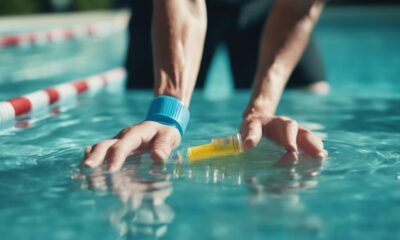
 Pool Maintenance2 months ago
Pool Maintenance2 months agoMaster Chemical Balancing: Secrets to a Safe and Crystal-Clear Pool
-

 Swimming Pools2 months ago
Swimming Pools2 months agoDIY Fun: Homemade Swimming Pool Ideas
-

 Aesthetic and Design2 months ago
Aesthetic and Design2 months agoSmall Wonders: Small Garden Swimming Pool Ideas
















